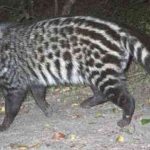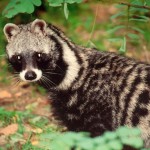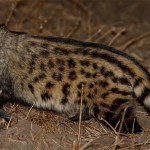The African Civet, a nocturnal member of the Viverridae family from sub-Saharan Africa, is known for its distinctive black-and-white striped fur and raccoon-like black eye circles. Its large hindquarters also contribute to its unique appearance.
In addition to its unique appearance, the African Civet has an interesting behavior: it can release a potent scent to mark its territory. This scent is used to establish and defend its area, making it a key part of its social behavior and territorial management.
Life Cycles & Lifespan
They typically live for 15 to 20 years. These animals secrete a substance from their perineal gland called Civettictis civetta, which is often the target of exploitation. The same scent they use to mark their territory is also utilized as a base for many human perfumes.
The glands used to produce the substance are bigger int he male species than in the female and they produce more secretion. Known as Musk, it is something that has been used throughout the centuries, and although alternatives have been found, it is still used in some cosmetics around the world.
Also read:
African Civet Facts
The average weight for an African Civet is 15 to 44 pounds, having a lot of variation and their length is usually about 13 to 19 inches. They have a very elongated body which makes them appear to have stubby little legs. Other defining characteristics are their short thick neck, small ears and a muzzle that comes to a point at the end of it. Small beady eyes surrounded by black circles and a very long bushy tail make them different than any other animal around.
Like humans, African Civets have five digits on each paw, but the first digit is set further back compared to the others. They possess 40 strong teeth, making them well-adapted for a carnivorous diet. Their fur is wiry and coarse, varying in color from red to yellow, and often features spots, stripes, or blotches in shades like brown or black.
Habitat
They live in the sub-Saharan Desert.
Images, Pics, Pictures and Photos of African Civet :







Behavior
It is a carnivore which means that it primarily eats. Usually feasting on the eggs of other vertebrates, it is also capable of eating venomous invertebrate beings such as snakes and other reptiles.
Mating for this species is during the hot and wet months of the summer between August and January. The female is responsible for creating a nest for the young and does so in the rich vegetation to hide offspring from prey and to keep them safe.
Normally she will not do the work herself, instead opts to find abandoned holes that have been dug by other creatures and left behind. The species is kept replenished by the females ability to have up to three separate liters within the course of one year. They normally only produce one to four young at a time, which are born at a more advanced stage than other animals, more mature and able to survive outside of the mother.
When offspring are born they are born with short fur, and dark, and can crawl from the time that they are birthed. After only 18 days they are able to venture out into the world on their own. Although able to leave the nest, they are still reliant upon their mother for milk and need her full protection for at least another 2 months.
Also read:






